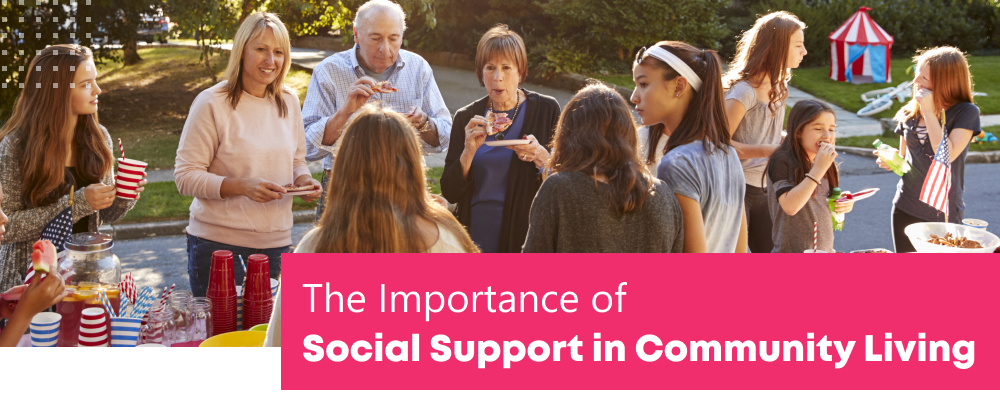The Importance of Social Support in Community Living
As a dedicated real estate expert, I understand that creating a thriving community within multi-unit properties goes beyond just providing a place to live. One critical element often overlooked is social support in community living. Social support not only enhances the quality of life for residents but also contributes to the overall success and harmony of a community. Fostering a supportive environment can lead to higher tenant satisfaction, better retention rates, and a more vibrant living space.
Benefits of Social Support in Community Living
- Improved Mental Health and Well-being
Social connections are vital for mental health. Residents who feel supported by their community tend to experience lower levels of stress and anxiety. Regular social interactions can reduce feelings of loneliness and isolation, leading to happier, more content tenants. - Enhanced Physical Health
Social support in community living can also positively impact physical health. Engaging in community activities and having a network of supportive neighbors encourages a more active lifestyle. Studies have shown that people with strong social ties have lower rates of chronic illnesses and faster recovery times from health issues. - Increased Tenant Satisfaction and Retention
A sense of community creates a welcoming atmosphere where residents feel valued and connected. This can lead to increased tenant satisfaction and higher retention rates. Tenants are more likely to stay in a community where they have formed meaningful relationships and feel a part of something larger than themselves.
Strategies to Foster Social Support
- Organize Community Events
Community events are a fantastic way to bring residents together. Consider organizing regular events such as potlucks, movie nights, or holiday celebrations. These events provide opportunities for residents to meet, interact, and form bonds. - Promoting Inclusivity and Diversity
Ensuring that all residents feel included and valued is crucial. Promote inclusivity by celebrating diverse cultures and traditions through community events. Encourage residents to share their unique backgrounds and experiences, fostering mutual respect and understanding. - Sustaining Engagement
Maintaining residents’ engagement over time can be difficult. Regularly update and refresh community activities to keep them exciting and relevant. Encourage feedback from residents to continuously improve and adapt the community offerings.
Real-World Examples of Successful Community Support Programs
Many multi-unit properties have successfully implemented social support programs to enhance community living. For example, the Co-Housing Association of the United States has numerous case studies demonstrating the positive impact of intentional communities. Similarly, the National Multifamily Housing Council offers resources and examples of community-building initiatives in multi-unit properties.
Future Trends in Social Support for Community Living
- Technology-Driven Solutions
As technology continues to advance, integrating tech-driven solutions can enhance social support in community living. Consider implementing community apps that allow residents to connect, share information, and organize events digitally. Virtual events and online forums can also provide additional platforms for social interaction.- Smart Home Integration: Smart home technology can offer convenience and enhance safety. Features like smart locks, thermostats, and lighting systems can improve the living experience and foster a sense of security and community.
- Online Concierge Services: These services can help residents with everyday tasks such as booking amenities, organizing maintenance requests, and even arranging social gatherings.
- Focus on Wellness and Sustainability
Future trends indicate a growing focus on wellness and sustainability in community living. Programs that promote holistic well-being, such as wellness workshops, fitness classes, and eco-friendly initiatives, can strengthen social bonds while promoting a healthier lifestyle.- Green Spaces and Community Gardens: Creating more green spaces and community gardens encourages outdoor activities and offers a place for residents to engage with nature and each other.
- Sustainable Living Practices: Implementing recycling programs, energy-efficient appliances, and sustainable building materials can attract environmentally conscious residents and foster a community that values sustainability.
- Enhanced Community Engagement Programs
Fostering a sense of belonging through community engagement programs is crucial. These programs can range from social events to volunteer opportunities that bring residents together for a common cause.- Cultural and Recreational Activities: Organizing cultural festivals, movie nights, and recreational sports leagues can cater to diverse interests and help build stronger community bonds.
- Educational Workshops: Offering workshops on various topics, from financial literacy to personal development, can provide valuable resources to residents while encouraging community interaction.
- Intergenerational Living Initiatives
Intergenerational living initiatives are gaining popularity as they promote mutual support and understanding between different age groups. These initiatives can enhance the social fabric of a community by fostering connections across generations.- Shared Living Spaces: Creating shared living spaces that encourage interactions between younger and older residents can promote mutual learning and support.
- Intergenerational Programs: Organizing activities that involve both young and elderly residents, such as storytelling sessions, mentoring programs, and shared hobby groups, can build a cohesive and supportive community environment.
Conclusion: Building Stronger Communities
The importance of social support in community living cannot be overstated. By fostering a supportive environment, multi-unit property owners can enhance the quality of life for residents, improve tenant satisfaction, and create a thriving community. Implementing strategies such as organizing community events, creating shared spaces, and encouraging resident-led initiatives can significantly contribute to building stronger, more connected communities. For more insights and resources on property management and community building, explore guides from the National Apartment Association and the Urban Land Institute. Additionally, learn more about how OptivoCare is making a difference in community support and services by visiting OptivoCare.
